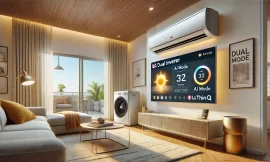
The importance of air conditioning in modern society: Air conditioning has become an essential aspect of modern life, ensuring comfort and productivity in homes, offices, and public spaces. As temperatures continue to rise due to climate change, the demand for effective cooling solutions has never been greater.
Evolution of cooling technology: From ancient civilizations using simple techniques like water evaporation to cool their surroundings to the invention of mechanical air conditioning systems in the 20th century, cooling technology has come a long way. Advancements in engineering and innovation have led to the development of even more sophisticated cooling solutions.
Introduction to smart air conditioning and its significance: Smart air conditioning represents the next frontier in cooling technology. By integrating Internet of Things (IoT) technology and harnessing the power of intelligent sensors, automation, and artificial intelligence (AI), smart air conditioning systems offer a plethora of benefits and present exciting possibilities for the future.
I. Understanding Smart Air Conditioning
A. Definition and core principles
Smart air conditioning refers to the integration of advanced technology into traditional air conditioning systems to improve efficiency, comfort, and control. It combines IoT connectivity, intelligent sensors, and AI algorithms to create a seamless and personalized cooling experience.
B. Integration of IoT technology
A key aspect of smart air conditioning is its ability to connect to the internet, enabling seamless communication between various devices. Through IoT technology, users can monitor and control their cooling systems remotely, ensuring optimal comfort and energy efficiency.
C. Real-time monitoring and data analysis
Smart air conditioning systems continuously collect and analyze data in real-time. This data includes temperature, humidity, occupancy, and air quality information. By analyzing this data, the system can make informed decisions to optimize cooling performance and provide a comfortable environment.
II. Features and Benefits of Smart Air Conditioning
- Energy efficiency and cost savings: One of the most significant advantages of smart air conditioning is its energy efficiency. By leveraging real-time data analysis and automation, these systems can adjust cooling levels based on occupancy and external factors, effectively reducing energy waste and lowering utility bills.
- Improved comfort and personalized settings: Smart air conditioning systems offer enhanced comfort through personalized settings. Users can customize temperature and airflow preferences, ensuring individualized comfort and avoiding unnecessary cooling in unoccupied areas.
- Remote access and control: The convenience of remote access and control is a standout feature of smart air conditioning. Whether at work, on vacation, or simply in another room, users can adjust settings, monitor energy usage, and receive notifications directly through their smartphones or other connected devices.
- Integration with smart home systems and voice assistants: Smart air conditioning seamlessly integrates with other smart home devices and voice assistants. Users can create comprehensive automation routines and voice commands that synchronize cooling, lighting, and other smart features to optimize energy usage and enhance the overall experience.
III. Intelligent Sensors and Automation
A. Role of sensors in smart air conditioning
Intelligent sensors play a crucial role in smart air conditioning systems. They gather data from the surrounding environment, enabling the system to make informed decisions and adjustments in real-time.
B. Sensing temperature, humidity, and air quality
Smart air conditioning systems utilize sensors to measure temperature, humidity, and air quality accurately. These measurements allow the system to adjust cooling levels and activate filtration and purification technologies, ensuring optimal indoor air quality.
C. Automation based on user behavior and preferences
Through machine learning and AI algorithms, smart air conditioners can learn and adapt to user behavior and preferences. The system analyzes historical data to predict user patterns and automatically adjusts cooling settings accordingly, ensuring personalized comfort and reducing the need for manual control.
IV. Air Quality Management
A. The impact of air quality on health and well-being
The quality of indoor air plays a vital role in human health and well-being. Poor air quality can lead to respiratory issues, allergies, and general discomfort. Smart air conditioning systems actively monitor and improve air quality, helping to create a healthier indoor environment.
B. Filtration and purification technologies in smart air conditioning
Smart air conditioning systems often incorporate advanced filtration and purification technologies. These technologies effectively capture and eliminate airborne pollutants, allergens, and even bacteria, promoting clean and breathable air within the living or working space.
C. Smart detection and alerts for poor air quality
In addition to filtration and purification, smart air conditioning systems can detect fluctuations in air quality. By continuously monitoring air particulate levels, volatile organic compounds (VOCs), and other pollutants, the system can provide alerts or automatically adjust settings to maintain optimal air quality.
V. Adaptive Cooling and AI Algorithms
- Machine learning and AI algorithms in smart AC systems: The integration of machine learning and AI algorithms enables smart air conditioning systems to learn and adapt. These algorithms analyze user behavior, environmental factors, and historical data to optimize cooling levels, enhancing energy efficiency and overall performance.
- Adapting cooling levels based on occupancy and external factors: Smart air conditioning systems use AI algorithms to adapt cooling levels based on occupancy and external factors. By monitoring room occupancy and analyzing external weather conditions, the system can adjust cooling intensity to match the needs of the space, minimizing energy waste without compromising on comfort.
- Energy optimization and predictive analysis: Through predictive analysis, smart air conditioning systems can optimize energy consumption. By considering factors such as weather forecasts and user patterns, the system can proactively adjust cooling settings to conserve energy and decrease utility costs.
VI. Smart AC and Sustainability
A. Contribution to reducing carbon footprint
Smart air conditioning systems contribute significantly to reducing carbon emissions. By optimizing energy usage and enabling remote control and automation, these systems minimize energy waste and promote sustainable cooling practices.
B. Integration with renewable energy sources
Many smart air conditioning systems integrate seamlessly with renewable energy sources such as solar power. By harnessing clean energy, these systems further reduce reliance on fossil fuels, making cooling more environmentally friendly.
C. Smart grid interaction and demand response capabilities
Smart air conditioning systems can interact with the smart grid infrastructure. During peak demand periods, the system can respond to demand reduction signals, automatically adjusting cooling settings or temporarily reducing energy consumption to support the grid, relieving stress on the energy network.
VII. Challenges and Limitations
A. Compatibility issues with older infrastructure
One of the challenges faced by smart air conditioning systems is compatibility with older infrastructure. Upgrading existing infrastructure to support IoT connectivity and smart features may be necessary to fully leverage the benefits of smart air conditioning.
B. Potential cybersecurity risks
As with any connected technology, smart air conditioning systems are susceptible to cybersecurity risks. It is crucial for manufacturers to prioritize robust security measures to protect user privacy and prevent unauthorized access to these systems.
C. Affordability and accessibility concerns
While the benefits of smart air conditioning are undeniable, the affordability and accessibility of these systems remain a concern. The initial cost of smart air conditioning systems may pose a barrier to widespread adoption, limiting accessibility for certain demographics.
VIII. Future Developments and Innovations
A. Advancements in smart AC technology
The future holds exciting possibilities for smart air conditioning technology. Advancements in sensors, AI algorithms, and connectivity will continue to improve energy efficiency, user experience, and integration with other smart devices, paving the way for even smarter and more intuitive cooling solutions.
B. Integration with smart city infrastructure
Smart air conditioning systems are likely to integrate with broader smart city infrastructure. By utilizing citywide data and coordinating with other IoT-enabled services, such as smart traffic management or energy networks, cooling systems can contribute to more efficient and sustainable urban environments.
C. Multi-zone and personalized cooling solutions
Future developments may focus on multi-zone cooling solutions that cater to individual preferences in different areas of a space. This level of personalized comfort can be achieved through advanced sensors and AI algorithms, allowing different rooms or zones to have tailored temperature settings within a single smart air conditioning system.
IX. Conclusion
A. Recap of the transformative impact of smart air conditioning
Smart air conditioning represents a transformative shift in cooling technology. Through IoT integration, sensors, automation, and AI, these systems provide enhanced comfort, energy efficiency, and air quality management, revolutionizing the way we cool our surroundings.
B. The potential for a sustainable and comfortable future
With the development and adoption of smart air conditioning systems, we are moving towards a sustainable and comfortable future. By optimizing energy usage, integrating renewable energy sources, and prioritizing air quality, smart air conditioning contributes to a healthier environment and plays a crucial role in building a sustainable society.


